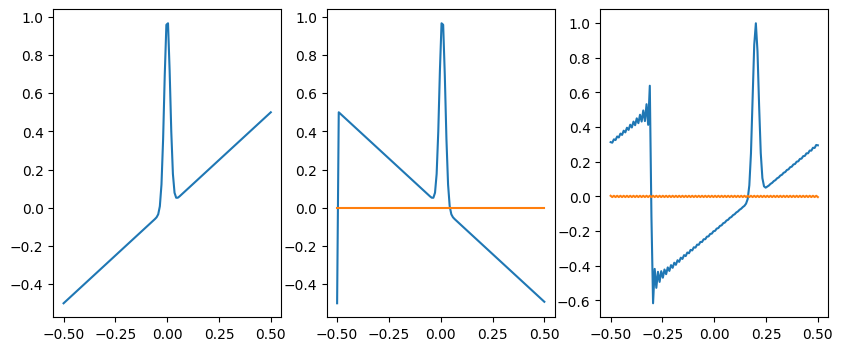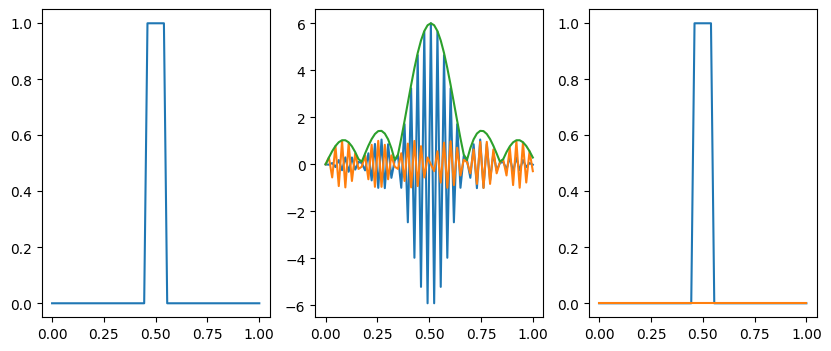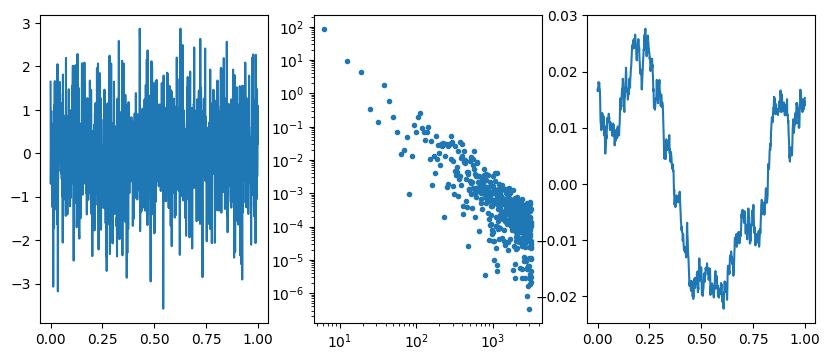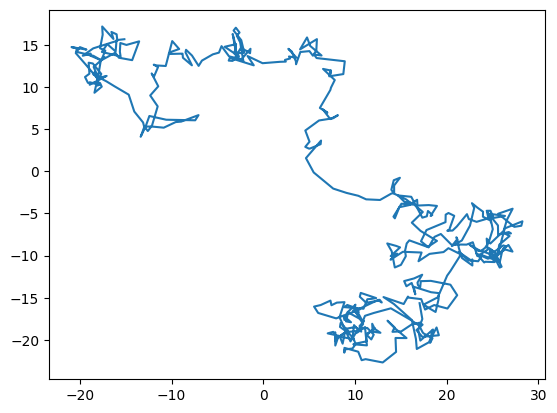More on the 1D DFT#
import numpy as np
import scipy.linalg
import matplotlib.pyplot as plt
def do_plots(f):
g = np.fft.fft(f)
plt.clf()
fig = plt.figure(figsize=(10,3))
plt.subplot(131)
plt.plot(x, f)
plt.subplot(132)
plt.plot(x, np.real(g))
plt.plot(x, np.imag(g))
plt.subplot(133)
h = np.fft.ifft(g)
plt.plot(x, np.real(h))
plt.plot(x, np.imag(h))
plt.show()
# Question 1
# Look at sin(kx) and cos(kx)
n = 32
x = np.linspace(0,n-1,n)
dx = x[1]-x[0]
k = 2*np.pi * (2/n)
do_plots(np.cos(k*x))
do_plots(np.sin(k*x))
# when we add n to the frequency, we get the same answer
# the result is aliased back into our range
k = 2*np.pi * (2/n + n)
do_plots(np.cos(k*x))
# a non-integer frequency gives leakage into other bins
# the discontinuity at the boundaries leads to high freq components
k = 2*np.pi * 3.33/n
do_plots(np.cos(k*x))
<Figure size 640x480 with 0 Axes>

<Figure size 640x480 with 0 Axes>

<Figure size 640x480 with 0 Axes>

<Figure size 640x480 with 0 Axes>

# Gaussian
n = 128
x = np.linspace(-0.5,0.5,n)
dx = x[1]-x[0]
f = np.exp(-(x-0)**2/(0.02**2))
g = np.fft.fft(f)
fig = plt.figure(figsize=(10,3))
plt.subplot(131)
plt.plot(x, f)
plt.subplot(132)
gs = np.fft.fftshift(g)
plt.plot(x, np.real(gs))
plt.plot(x, np.imag(gs))
plt.plot(x, np.abs(gs))
plt.subplot(133)
# Check the inverse transform
h = np.fft.ifft(g)
plt.plot(x, np.real(h))
plt.plot(x, np.imag(h))
plt.show()
# Check Parseval's theorem
sumf = np.sum(np.abs(f)**2)
sumg = np.sum(np.abs(g)**2)/n
print('Parseval check:', sumf, sumg, sumf-sumg)
plt.clf()
# This shows that the real part is symmetric about k=0
# but the imaginary part is anti-symmetric; therefore F(-k) = F^*(k)
fig = plt.figure(figsize=(10,3))
plt.subplot(121)
k = np.fft.fftfreq(n)
plt.plot(k[k>0], np.real(g[k>0]))
plt.plot(-k[k<0], np.real(g[k<0]))
plt.subplot(122)
plt.plot(k[k>0], np.imag(g[k>0]))
plt.plot(-k[k<0], np.imag(g[k<0]))

Parseval check: 3.18341790878128 3.18341790878128 0.0
[<matplotlib.lines.Line2D at 0x11cdbe780>]
<Figure size 640x480 with 0 Axes>

# Question 2: manipulating f(x) by changing F(k)
n = 128
x = np.linspace(-0.5,0.5,n)
dx = x[1]-x[0]
f = np.exp(-(x-0)**2/(0.02**2)) + x
g = np.fft.fft(f)
fig = plt.figure(figsize=(10,4))
plt.subplot(131)
plt.plot(x, f)
plt.subplot(132)
# complex conjugate is equivalent to x->-x
h = np.fft.ifft(np.conjugate(g))
plt.plot(x, np.real(h))
plt.plot(x, np.imag(h))
plt.subplot(133)
# add a gradient in phase is equivalent to a translation in x
j = complex(0,1)
k = (2*np.pi/dx) * np.fft.fftfreq(n)
g = g * np.exp(-j * k * 0.2)
h = np.fft.ifft(g)
plt.plot(x, np.real(h))
plt.plot(x, np.imag(h))
plt.show()

# Question 3: convolution
import scipy.signal
def convolution(f,g):
ft = np.fft.fft(f)
gt = np.fft.fft(g)
return np.fft.ifft(ft*gt)
n = 1024
x = np.linspace(-0.5,0.5,n)
dx = x[1]-x[0]
f = np.exp(-(x)**2/(0.02**2))
g = np.zeros_like(x)
g[(x>-0.2)&(x<0.2)] = 1
plt.plot(x,f)
plt.plot(x,g)
h = convolution(g,f)
h = np.roll(h, n//2) # shift the result to centre it
plt.plot(x,np.real(h)/np.max(np.real(h)))
# Compare against the scipy convolution function
h = scipy.signal.convolve(g,f, mode='same')
plt.plot(x,h/np.max(h),':')
[<matplotlib.lines.Line2D at 0x12d07fce0>]

# This wasn't one of the questions, but have a look at the
# top hat <-> sinc function transform
n = 64
x = np.linspace(0,1,n)
dx = x[1]-x[0]
f = np.zeros_like(x)
f[(x>0.45)&(x<0.55)] = 1
g = np.fft.fft(f)
fig = plt.figure(figsize=(10,4))
plt.subplot(131)
plt.plot(x, f)
plt.subplot(132)
gs = np.fft.fftshift(g)
plt.plot(x, np.real(gs))
plt.plot(x, np.imag(gs))
plt.plot(x, np.abs(gs))
plt.subplot(133)
h = np.fft.ifft(g)
plt.plot(x, np.real(h))
plt.plot(x, np.imag(h))
plt.show()

# Question 4: red noise and random walk
n = 1024
x = np.linspace(0,1,n)
dx = x[1]-x[0]
f = np.random.randn(n)
g = np.fft.fft(f)
fig = plt.figure(figsize=(10,4))
plt.subplot(131)
plt.plot(x, f)
plt.subplot(132)
g2 = g.copy()
j = complex(0,1)
k = (2*np.pi/dx) * np.fft.fftfreq(n)
g2[1:] /= j*k[1:]
plt.plot(k[k>0], np.abs(g2[k>0])**2, '.')
plt.yscale('log')
plt.xscale('log')
plt.subplot(133)
h = np.fft.ifft(g2)
plt.plot(x, np.real(h))
#plt.plot(x, np.imag(h))
plt.show()
plt.clf()
plt.plot(np.real(h[:n//2])/dx, np.real(h[n//2:])/dx)
plt.show()


In this question, we generate a sample of red noise which has a power spectrum \(1/k^2\) by taking the Fourier transform of white noise (flat power spectrum) and dividing the Fourier transorm by \(ik\). This is equivalent to integrating the white noise, since
\[g(x) = \int^x dx^\prime f(x^\prime) = \int^x dx^\prime \int dk\ F(k) e^{ikx^\prime} = \int dk\ F(k) \int^x dx^\prime e^{ikx^\prime} = \int dk\ {F(k)\over ik} e^{ikx}.\]
When we take the samples of red noise and plot them, we see a random walk (you can see that the distance travelled is \(\sim \sqrt{N}\) as expected). Individual steps in the random are uncorrelated (white noise) but because successive steps add up over time (integrate) we get a red noise spectrum in the end.
This is an interesting way to generate a random walk.
